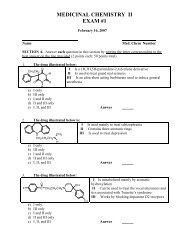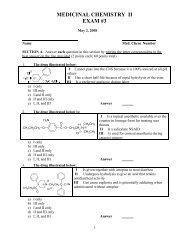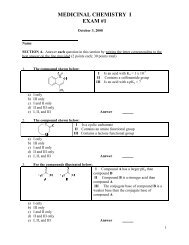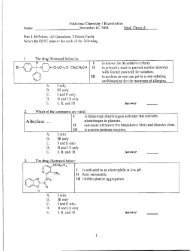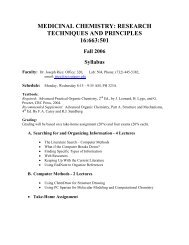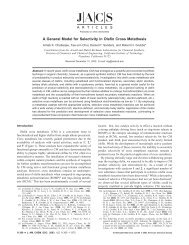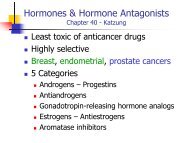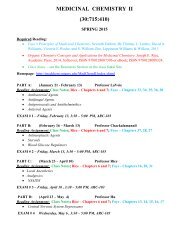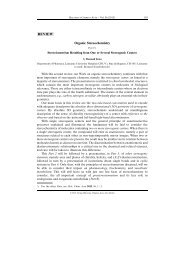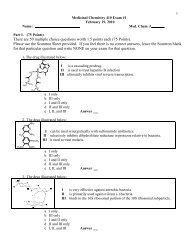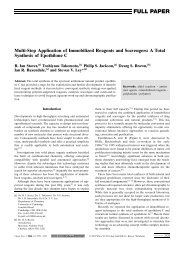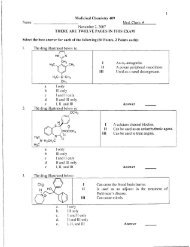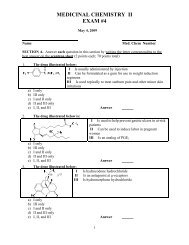Baldwin's Rules - Department of Medicinal Chemistry
Baldwin's Rules - Department of Medicinal Chemistry
Baldwin's Rules - Department of Medicinal Chemistry
Create successful ePaper yourself
Turn your PDF publications into a flip-book with our unique Google optimized e-Paper software.
Chemical Reviews REVIEW<br />
Scheme 12. Lack <strong>of</strong> Efficient 5-endo-dig Closures in PhSH<br />
and Bu 3SnH-Radical Reactions <strong>of</strong> 1,5-Hexadiynes<br />
Scheme 13. 5-endo-dig Radical Cyclization <strong>of</strong> Si-Centered<br />
Radical<br />
terminal and phenyl-sustituted alkynes in up to 83% yield. Only<br />
when R1 was an ethyl group did 5-endo-dig closure become<br />
competitive (4-exo/5-endo ratio = 2.5:1). In accordance with the<br />
experimental findings, DFT calculations found that the 4-exo<br />
pathway is strongly preferred kinetically over the 5-endo process<br />
for R = Ph but by a much smaller margin (0.8 kcal/mol) when R =<br />
Me (Scheme 11). This important work suggests that efforts into<br />
these unusual radical cyclizations (4-exo-dig) should be continued.<br />
The above report is consistent with earlier observations that<br />
most vinyl radicals generated by addition <strong>of</strong> radical species to the<br />
terminal carbon <strong>of</strong> 1,5-hexadiynes do not undergo 5-endo-dig<br />
closure or do it very inefficiently (Scheme 12). 78 The bulk <strong>of</strong> the<br />
reaction mixtures corresponds to polymeric materials which were<br />
proposed to originate from the 4-exo products, unstable under<br />
the reaction conditions. For PhS-substituted radicals, attack at<br />
the phenyl ring is preferred to 5-endo-dig cyclization.<br />
The first efficient 5-endo-dig cyclization under kinetic control<br />
was reported by Studer and co-workers for a Si-centered radical<br />
(Scheme 13). 85 The increased efficiency <strong>of</strong> this 5-endo cyclization<br />
is in excellent agreement with the calculated low cyclization<br />
barrier <strong>of</strong> ∼6 kcal/mol. 83 In addition to the stereoelectronic<br />
consequences caused by the presence <strong>of</strong> long C Si bonds, this<br />
process is assisted by the captodative SOMO LUMO and<br />
HOMO SOMO interactions and the β-Si-effect. 86<br />
The first efficient 5-endo-dig radical closure <strong>of</strong> a carboncentered<br />
radical, reported by Alabugin et al., 78 was discovered<br />
when radical cyclizations <strong>of</strong> 1,5-diynes were triggered with tosyl<br />
radicals (Scheme 14). The 5-endo-dig product was formed in<br />
51 72% yield upon photolytical generation <strong>of</strong> Ts radicals from<br />
TsBr at the room temperature. Yields were noticeably lower<br />
(2 23%) upon thermal activation (refluxing C 6H 6, AIBN).<br />
Interestingly, the cyclizations were also stereoselective, since<br />
the sulfonyl moiety is capable <strong>of</strong> selectively lowering the activation<br />
barrier for 5-endo-dig closure through a favorable hydrogenbonding<br />
interaction with the relatively acidic acetylenic C H<br />
bond (Table 12). A favorable stereoelectronic alignment <strong>of</strong> the<br />
vicinal diols (the gauche effect 87 ) preorganized the two π-systems<br />
for cyclization without the introduction <strong>of</strong> concomitant strain.<br />
Scheme 14. First Efficient 5-endo-dig Cyclization <strong>of</strong> a<br />
Carbon-Centered Radical<br />
Table 12. Activation and Reaction Energies (kcal/mol)<br />
for 4-exo-dig and 5-endo-dig Cyclizations Calculated<br />
at the UBLYP/6-311+G**//UBLYP/6-31G** Level<br />
Both the increased efficiency <strong>of</strong> the 5-endo-dig cyclization and the<br />
observed stereoselectivity were fully supported by calculated activation<br />
barriers for the cyclizations. The sulfonyl group introduction<br />
next to the radical center leads to a >2 kcal/mol decrease in the<br />
5-endo-dig activation barrier, which is sufficient for switching the<br />
selectivity toward the five-membered ring formation (Table 12).<br />
An earlier report <strong>of</strong> the 5-endo-dig closure <strong>of</strong> O- and S-centered<br />
radicals, formed from 2-methoxyphenyl and 2-methylthiophenyl<br />
substituted phosphorus ylides, proceeded only under drastic conditions<br />
(flash vacuum pyrolysis (FVP) at 850 °C, Scheme 15). 88<br />
The activation barriers for these closures were calculated by<br />
Alabugin and Manoharan (Table 13). 83 As evidenced by the experimental<br />
conditions, the cyclizations are only expected to proceed<br />
under high temperatures. The trends in calculated reaction<br />
energies are controlled by the interplay <strong>of</strong> gain <strong>of</strong> aromatic stabilization<br />
and loss <strong>of</strong> conjugative radical stabilization as the starting<br />
materials are transformed into the products. The differences in<br />
reaction exothermicities are partially translated into the activation<br />
barriers. Interestingly, the cyclizations <strong>of</strong> CN and NMe2<br />
substituted radicals (Entries 4, 5) have almost identical reaction<br />
energies but the barrier is more than 10 kcal/mol lower in the<br />
case <strong>of</strong> the donor substituent. The data strongly suggest that both<br />
the activation energy (ΔE q ) and the intrinsic reaction barrier<br />
(ΔE o) decrease dramatically when electron density increases at<br />
the radical center. 89<br />
O dx.doi.org/10.1021/cr200164y |Chem. Rev. XXXX, XXX, 000–000



